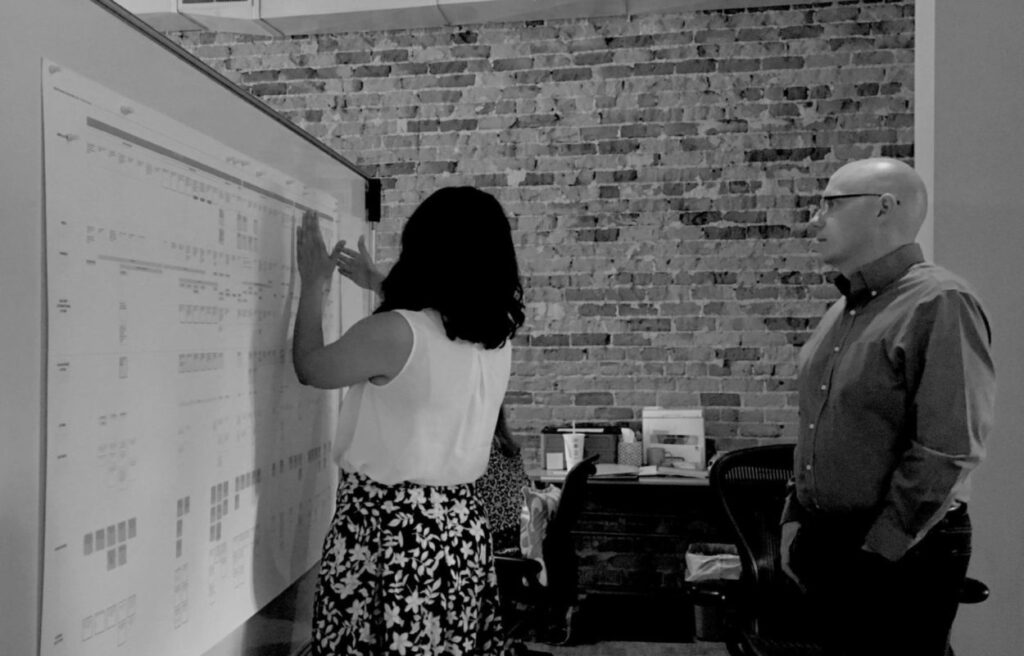Does this sound familiar?
You have a product that is underperforming, and you need to change your strategy, but you have no idea where to start. While your team is bustling with new product or feature ideas, they’re all great, but the budget is tight. How do you prioritize? How do you select the one idea to move forward with?
Too many opinions on strategy? No alignment among team members? And, what about that very vocal, opinionated person who always seems to get their way, making the rest of the team feel voiceless. You might also notice that inside your team are people who have brilliant ideas, yet are too shy to share them in a group.
Any of those scenarios sound familiar? We see them frequently. That’s why we began introducing the concept of design sprints to our clients.
What’s a design sprint?
A design sprint is a fast-paced design process developed by Google Ventures. It condenses weeks of discovery work into five days. The most important part of the design sprint is that it helps create alignment within your team in a matter of a few hours.
How does a design sprint work?
Design sprints are highly effective in achieving alignment because they use a fine-tuned framework, created and perfected by Google Ventures.
Unlike many ideation processes that lack a framework, Google’s structured approach addresses common challenges to which many of us can relate – too many voices, repetition, endless debating, meetings on top of meetings, and in the end not really getting anywhere. Google mastered the ideation process with a design sprint, and we’ve adapted their framework to help our own clients. Here’s what a typical week looks like:

Day 1
The sprint launches with a full-day workshop where our design sprint specialists gather remotely with your team on a collaborative digital platform. During the workshop, our teams identify and clearly define the challenge you need to solve, and then generate hundreds of opportunities to solve that challenge – you read that right … hundreds. Next, we vote and start ideating solutions.
Everyone participates and contributes equally. How? It’s a mix of individual exercises and teamwork. We ideate in private, share anonymously through the workshop facilitator and come together to vote. No explaining, no promotion, no campaigning for the best idea. The vote results in a winner.
Day 2
Our team quickly creates a prototype for the selected concept and defines its core workflows. During this time, we also identify users to test the prototype.
Day 3
We define the usability test and fine-tune the prototype.
Day 4
We put the concept in front of users and solicit their feedback, while observing how they interact with the product.
Day 5
The sprint concludes with a comprehensive list of insights from the usability testing and clear next steps on how your team should bring the product to market.
That sounds like a lot to pack in a week isn’t? It is, but we’ve done it and it works. The key? Having a consistent and proven process. How much of your time is needed? We need a commitment from you and your team to attend the first full day, and then only an hour or two at the end of the week when we present the final report.
Critical analysis: Is a design sprint for you?
Design sprints have gained wide appeal for a reason. Speed matters. In the current business climate, where companies must pivot quickly, a week of intensive collaboration can replace months of research and long, costly design processes. Design sprints are most effective when you need to:
- Cast a future product vision that your whole team will support
- Align and agree on the next direction for your product or service
- Shift a strategy quickly, while minimizing risk
- Test a new customer experience
- Identify ways to attract new customers
- Test the viability of a new product concept
Design sprints have the most impact when applied to simple products that have clear and straightforward use cases. For more complex products, you might consider running a design sprint for a core portion of the product or a single use case. Then once you have feedback from real users, you can dive into a full product design and development project.
After the design sprint …
Your team might think that after the design sprint is complete, the prototype is ready to be passed on to development. We normally suggest going through a second design iteration to address the insights that were gathered during user interviews. The user interviews might reveal that there is further work to be done, a new opportunity to tackle, or a change to the core workflow that requires some deeper thought. You’ll only know how to proceed after testing the prototype with real users.
You might also think that once you’ve completed a design sprint, that’s it. Thorough research and design must be ongoing. Delivering extraordinary experiences takes continual deep learning and time. Design sprints have proven to be a structured, highly-effective method for removing any obstacles early in the ideation phase of product development, particularly challenges around team alignment and ideation. A design sprint is a highly effective and efficient way to condense weeks of discovery into days to build a winning product.



